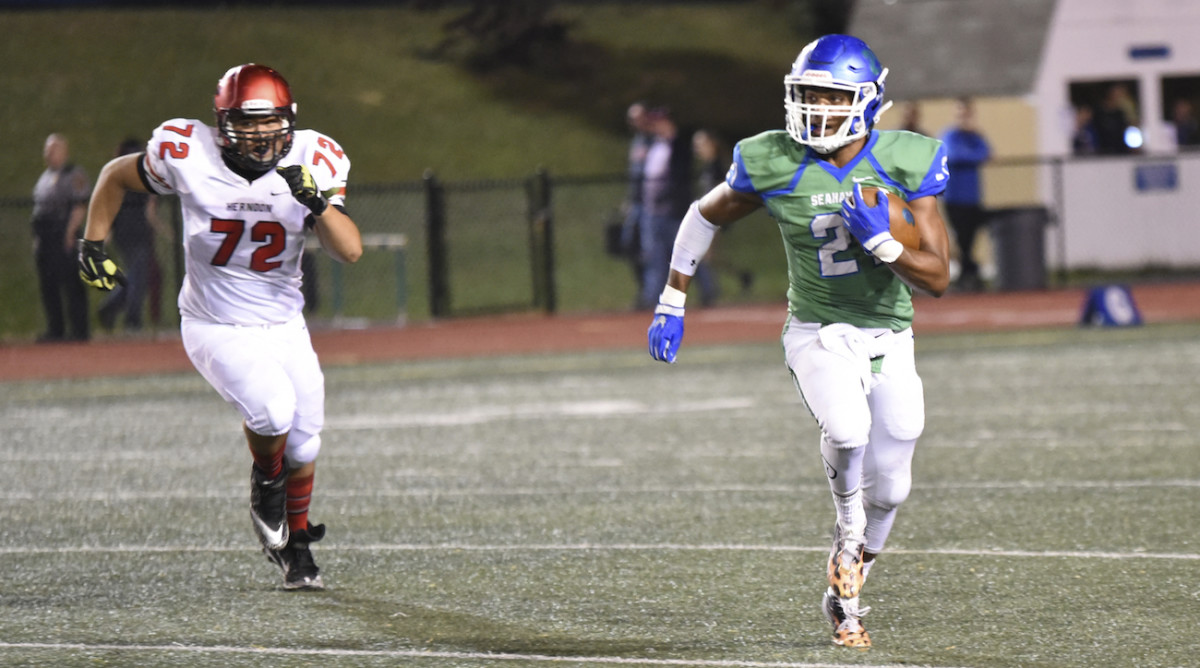What it Means to Secure an Athletic Scholarship

When most people hear the words “athletic scholarship,” they think of four years of free college, five-star athletes, highlight reels on YouTube, televised commitment press conferences, articles in magazines, and interviews on SportsCenter.
However, that’s not the full story. Not every athlete is on the national radar. Not every athlete has a cult following. Not every scholarship covers everything; some may only cover two years, some may only pay for books. It depends on the athlete and the school.
Around 2% of all college athletes are on scholarship, per CBS News, and as their high school days draw to a close, seniors need to prove to schools on the field and in the classroom that they would be a good investment.
Take for instance Olivia Duston, an All-Metropolitan runner and soccer player, who won the 2018 Virginia state championship in the 1,000 meters and, along with her Herndon High School teammates, finished 10th in the sprint medley relay at the 2018 New Balance Indoor Track and Field Nationals. She plans to run for all four years at Virginia Tech, but her scholarship only covers part of the cost.
“As of now, my scholarship covers about a third of my tuition,” says Olivia, “but the head track coach there said that [if I perform well], the amount of money can go up.” These are known as incentives, goals for athletes to strive towards so they can receive more tuition money. These can include performance on the field, in the classroom, or progression in skills throughout the year.
Not all D-1 schools offer scholarships. Schools within the Ivy League, such as Harvard and Princeton, only offer need-based financial aid.
Spencer Alston was selected to the All-Region team in Northern Virginia and All-Metropolitan team as a running back for South Lakes High School in Reston, Virginia. During the 2017–18 football season, he ran for 1,509 yards and 22 touchdowns and added 824 receiving yards and 11 touchdowns. He committed to Ohio State University on a four-year lacrosse scholarship, but he really wanted to play football as well. The football team could not guarantee him a spot on the roster, so he decided to go to Yale, which guaranteed him a spot on the football team. Instead of a scholarship, he will receive financial aid, which will lower his cost of tuition and fees.

“I fell in love with football more [than lacrosse],” replied Spencer, when asked why he chose Yale over Ohio State. “I wanted the best education possible, so I decided to go to Yale.”
Off-the-field expectations are high for athletes as well.
“Grades are very important,” says South Lakes football coach Trey Taylor. “[Colleges] want to make sure that the kids are doing what they’re supposed to do in the classroom. They want to know what kind of player he is to coach, what kind of teammate is he, what kind of person he is in the community.”
Added Spencer, “You have to hold yourself to a [high standard], especially off the field because of all the gear. If you do something [you’re not supposed to], then it would be easy for people to pick you out.” If the offense is considered high enough, athletes can have their scholarships rescinded and can even be asked to not attend the university.
“[Our coaches] go and recruit the right types of student athletes,” says Georgetown Athletic Director Lee Reed. Reed, who is in his eighth year at Georgetown, has had more than 16 years of experience in this department, including stints at Eastern Michigan University and Cleveland State.
What makes a student athlete the right fit? “It’s a combination of things,” says Reed. “Certainly athletic skill, the fit with the university and the team, academics, and character. The position you play, the level of skill you have, your academic acumen, the type of person you are; those things all factor into who we offer scholarships to.”
Georgetown has 29 varsity sports, but “a select few are not NCAA sports or [the university] has not invested scholarships in them.” Reed said that even though some sports do not have scholarship programs, the coaches will still actively recruit.
According to the NCAA, there are more than 480,000 collegiate athletes, and while not all of them may be on scholarship, their journeys to competing in their sports on the collegiate level include on-field performance and being constructive members of their classrooms and communities.
“I am extremely excited [to run at Virginia Tech],” says Olivia. “The program is known for showing positive progression with their athletes, and I can’t wait to see what I am capable of in college!”
Photographs by Jon Fleming (Olivia); Dion Seneca Photography (Spencer)
